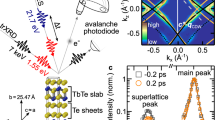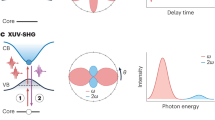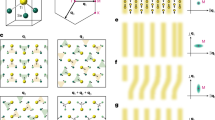Abstract
In the prevalent picture of ultrafast structural phase transitions, atomic motion occurs in a slowly varying potential energy surface adiabatically determined by fast electrons. However, this ignores non-conservative forces caused by electron–lattice collisions, which can substantially influence atomic motion. Most ultrafast techniques only probe the average structure and are less sensitive to random displacements and therefore do not detect the role played by non-conservative forces in phase transitions. Here we show that the lattice dynamics of the prototypical insulator–metal transition of vanadium dioxide cannot be described by potential energy alone. We use the sample temperature to control the preexisting lattice disorder before ultrafast photoexcitation across the phase transition and our ultrafast diffuse scattering experiments show that the fluctuations characteristic of rutile metal develop equally fast (120 fs) at initial temperatures of 100 and 300 K. This indicates that additional non-conservative forces are responsible for the increased lattice disorder. These results highlight the need for more sophisticated descriptions of ultrafast phenomena beyond the Born–Oppenheimer approximation as well as ultrafast probes of spatial fluctuations beyond the average unit cell measured by diffraction.
This is a preview of subscription content, access via your institution
Access options
Access Nature and 54 other Nature Portfolio journals
Get Nature+, our best-value online-access subscription
$29.99 / 30 days
cancel any time
Subscribe to this journal
Receive 12 print issues and online access
$209.00 per year
only $17.42 per issue
Buy this article
- Purchase on Springer Link
- Instant access to full article PDF
Prices may be subject to local taxes which are calculated during checkout




Similar content being viewed by others
Data availability
Source data are available with this paper. Other data that support the findings of this study are available from the corresponding authors upon reasonable request.
Code availability
Computer codes used in this study are available from the corresponding authors upon reasonable request.
References
Fritz, D. M. et al. Ultrafast bond softening in bismuth: mapping a solid’s interatomic potential with X-rays. Science 315, 633–636 (2007).
Zeiger, H. J. et al. Theory for displacive excitation of coherent phonons. Phys. Rev. B 45, 768–778 (1992).
Baum, P., Yang, D.-S. & Zewail, A. H. 4D visualization of transitional structures in phase transformations by electron diffraction. Science 318, 788–792 (2007).
Sciaini, G. et al. Electronic acceleration of atomic motions and disordering in bismuth. Nature 458, 56–59 (2009).
Lindenberg, A. M. et al. Atomic-scale visualization of inertial dynamics. Science 308, 392–395 (2005).
Hillyard, P. B. et al. Carrier-density-dependent lattice stability in InSb. Phys. Rev. Lett. 98, 125501 (2007).
Morrison, V. R. et al. A photoinduced metal-like phase of monoclinic VO2 revealed by ultrafast electron diffraction. Science 346, 445–448 (2014).
Huber, T. et al. Coherent structural dynamics of a prototypical charge-density-wave-to-metal transition. Phys. Rev. Lett. 113, 026401 (2014).
Beaud, P. et al. A time-dependent order parameter for ultrafast photoinduced phase transitions. Nat. Mater. 13, 923–927 (2014).
Wall, S. et al. Ultrafast disordering of vanadium dimers in photoexcited VO2. Science 362, 572–576 (2018).
Li, J. et al. Direct detection of V-V atom dimerization and rotation dynamic pathways upon ultrafast photoexcitation in VO2. Phys. Rev. X 12, 021032 (2022).
Head-Gordon, M. & Tully, J. C. Molecular dynamics with electronic frictions. J. Chem. Phys. 103, 10137–10145 (1995).
Duffy, D. M. & Rutherford, A. M. Including the effects of electronic stopping and electron–ion interactions in radiation damage simulations. J. Phys.: Condens. Matter 19, 016207 (2006).
Darkins, R. & Duffy, D. M. Modelling radiation effects in solids with two-temperature molecular dynamics. Comput. Mater. Sci. 147, 145–153 (2018).
Darkins, R., Ma, P.-W., Murphy, S. T. & Duffy, D. M. Simulating electronically driven structural changes in silicon with two-temperature molecular dynamics. Phys. Rev. B 98, 024304 (2018).
Sun, Z. & Millis, A. J. Transient trapping into metastable states in systems with competing orders. Phys. Rev. X 10, 021028 (2020).
Comès, R., Felix, P., Lambert, M. & Villeneuve, G. Une transition métal–isolant dans V0,90Nb0,10O2 due à un appariement local des atomes de vanadium. Acta Cryst. A30, 55–60 (1974).
Budai, J. D. et al. Metallization of vanadium dioxide driven by large phonon entropy. Nature 515, 535–539 (2014).
Wang, X. et al. Role of thermal equilibrium dynamics in atomic motion during nonthermal laser-induced melting. Phys. Rev. Lett. 124, 105701 (2020).
Stern, M. J. et al. Mapping momentum-dependent electron-phonon coupling and nonequilibrium phonon dynamics with ultrafast electron diffuse scattering. Phys. Rev. B 97, 165416 (2018).
Chase, T. et al. Ultrafast electron diffraction from non-equilibrium phonons in femtosecond laser heated Au films. Appl. Phys. Lett. 108, 041909 (2016).
Berglund, C. N. & Guggenheim, H. J. Electronic properties of VO2 near the semiconductor-metal transition. Phys. Rev. 185, 1022 (1969).
Goodenough, J. B. The two components of the crystallographic transition in VO2. J. Solid State Chem. 3, 490–500 (1971).
Zylbersztejn, A. M. N. F. & Mott, N. F. Metal-insulator transition in vanadium dioxide. Phys. Rev. B 11, 4383 (1975).
McWhan, D. B., Marezio, M., Remeika, J. P. & Dernier, P. D. X-ray diffraction study of metallic VO2. Phys. Rev. B 10, 490 (1974).
Cavalleri, A., Dekorsy, T. H., Chong, H. H. W., Kieffer, J.-C. & Schoenlein, R. W. Evidence for a structurally-driven insulator-to-metal transition in VO2: a view from the ultrafast timescale. Phys. Rev. B 70, 161102 (2004).
Cavalleri, A. et al. Femtosecond structural dynamics in VO2 during an ultrafast solid-solid phase transition. Phys. Rev. Lett. 87, 237401 (2001).
Otto, M. R. et al. How optical excitation controls the structure and properties of vanadium dioxide. Proc. Natl Acad. Sci. USA 116, 450–455 (2019).
Gaffney, K. J. et al. Observation of structural anisotropy and the onset of liquidlike motion during the nonthermal melting of InSb. Phys. Rev. Lett. 95, 125701 (2005).
Ishikawa, T. et al. A compact X-ray free-electron laser emitting in the sub-ångström region. Nat. Photon. 6, 540–544 (2012).
Vidas, L. et al. Does VO2 host a transient monoclinic metallic phase? Phys. Rev. X 10, 031047 (2020).
Tamm, A. et al. Langevin dynamics with spatial correlations as a model for electron-phonon coupling. Phys. Rev. Lett. 120, 185501 (2018).
Wall, S. et al. Ultrafast changes in lattice symmetry probed by coherent phonons. Nat. Commun. 3, 721 (2012).
Qiu, T. Q. & Tien, C. L. Short-pulse laser heating on metals. Int. J. Heat Mass Transf. 35, 719–726 (1992).
Liu, H.-W. et al. Unifying the order and disorder dynamics in photoexcited VO2. Proc. Natl Acad. Sci. USA 119, e2122534119 (2022).
Trigo, M. et al. Fourier-transform inelastic X-ray scattering from time- and momentum-dependent phonon–phonon correlations. Nat. Phys. 9, 790–794 (2013).
Picano, A., Grandi, F., Werner, P. and Eckstein, M. Stochastic semiclassical theory for non-equilibrium electron-phonon coupled systems. Preprint at https://arxiv.org/abs/2209.00428 (2022).
Acknowledgements
G.A.d.l.P.M., Y.H., V.K., D.A.R., S.T. and M.T. were supported by the US Department of Energy, Office of Science, Office of Basic Energy Sciences, through the Division of Materials Sciences and Engineering under contract no. DE-AC02-76SF00515. A.A.C. was supported by the Center for Non-Perturbative Studies of Functional Materials Under Non-Equilibrium Conditions (NPNEQ) funded by the Computational Materials Sciences Program of the US Department of Energy, Office of Science, Basic Energy Sciences, Materials Sciences and Engineering Division, and performed under the auspices of the US Department of Energy by Lawrence Livermore National Laboratory under contract DE-AC52-07NA27344. O.D. was supported by the US Department of Energy, Office of Science, Basic Energy Sciences, Materials Sciences and Engineering Division, under award no. DE-SC0019978. A.S.J., E.P., L.V. and S.W. were funded through the European Research Council (ERC) under the European Union’s Horizon 2020 Research and Innovation Programme (grant agreement no. 758461) and PGC2018-097027-B-I00 project funded by MCIN/AEI/10.13039/501100011033/FEDER ‘A way to make Europe’ and CEX2019-000910-S (MCIN/AEI/10.13039/501100011033), Fundació Cellex, Fundació Mir-Puig and Generalitat de Catalunya (AGAUR grant no. 2017 SGR 1341, CERCA program). A.S.J. and E.P. acknowledge support from the Marie Skłodowska-Curie grant agreement no. 754510 (PROBIST). A.S.J. acknowledges support of a fellowship from ‘la Caixa’ Foundation (ID 100010434), fellowship code LCF/BQ/PR21/11840013, and the Agencia Estatal de Investigacion (the R&D project CEX2019-000910-S, funded by MCIN/AEI/10.13039/501100011033, Plan National FIDEUA PID2019-106901GB-I00, FPI). T.K. acknowledges support from JSPS KAKENHI (grant nos. JP19H05782, JP21H04974 and JP21K18944). Ultrafast X-ray measurements were performed at BL3 of SACLA with the approval of the Japan Synchrotron Radiation Research Institute (JASRI) (proposal nos. 2019A8038 and 2019B8075). Preliminary X-ray characterization was performed at the Stanford Synchrotron Radiation Lightsource (SSRL). Use of the SSRL is supported by the US Department of Energy, Office of Science, Office of Basic Energy Sciences, under contract no. DE-AC02-76SF00515.
Author information
Authors and Affiliations
Contributions
M.T., S.W. and O.D. conceived the initial experiment. M.T. supervised the project. G.A.d.l.P.M., Y.H., A.S.J., T.K., V.K., E.P., D.A.R., S.T., L.V., S.W. and M.T. performed the experiment at SACLA. G.A.d.l.P.M. analysed the data. M.T. and A.A.C. developed the model, and M.T., G.A.d.l.P.M. and S.Y. performed the simulations. M.T. and A.A.C. wrote the initial draft with feedback from all the authors.
Corresponding authors
Ethics declarations
Competing interests
The authors declare no competing interests.
Peer review
Peer review information
Nature Physics thanks Jorgen Larsson, Christoph Rau and Michael Sentef for their contribution to the peer review of this work.
Additional information
Publisher’s note Springer Nature remains neutral with regard to jurisdictional claims in published maps and institutional affiliations.
Extended data
Extended Data Fig. 1 Ab-inito molecular dynamics.
Ab-inito molecular dynamics (AIMD) of the disordering process after the electronic temperature is raised to 2200 K and kept fixed (see10 for details of the simulation). The plot shows the V-V distance as a function of time for multiple MD trajectories (black lines). Blue and red lines show the long and short bonds averaged over multiple unit cells. The lattice is initially at 300 (top) and 100 K (bottom). Note that this simulation is done under the Born-Oppenheimer approximation. The trajectories disorder faster starting at 300 K than when starting at 100 K.
Extended Data Fig. 2 Additional X-ray diffuse patterns.
Static x-rays scattering pattern at 100K with Brillouin zone boundaries shown for the VO2 M1 and M1’ domains, a) and b) respectively. Monoclinic Miller indices for each Brillouin zone are indicated. The M1’ domain is rotated by 90 degrees around the rutile c-axis from the M1 domain.
Extended Data Fig. 3 Fits of the time dependence.
Dashed lines are fits of an error function, Erf((t - μ)/σ), to the time dependent intensities of the Bragg and diffuse regions at 100K (left column) and 300K (right column) shown in Fig. 3 of the main text. The fitted μ and σ are given on the legend. The timescales quoted in the main text correspond to the full width at half maximum equivalent, FWHM = \(2\sqrt{2\ln (2)}\sigma\).
Source data
Source Data Fig. 2
Source data for the integrated intensity as a function of time for Bragg peaks (–122) and (–113) and for diffuse regions Q1 and Q2.
Source Data Fig. 3
Source data for the curves in Fig. 3.
Source Data Fig. 4
Tabulated values for the data plotted in Fig. 4f,g. The columns represent the temperatures (T = 0.002, 0.005, 0.010, 0.015) as described in the main text.
Rights and permissions
Springer Nature or its licensor (e.g. a society or other partner) holds exclusive rights to this article under a publishing agreement with the author(s) or other rightsholder(s); author self-archiving of the accepted manuscript version of this article is solely governed by the terms of such publishing agreement and applicable law.
About this article
Cite this article
de la Peña Muñoz, G.A., Correa, A.A., Yang, S. et al. Ultrafast lattice disordering can be accelerated by electronic collisional forces. Nat. Phys. 19, 1489–1494 (2023). https://doi.org/10.1038/s41567-023-02118-z
Received:
Accepted:
Published:
Issue Date:
DOI: https://doi.org/10.1038/s41567-023-02118-z
This article is cited by
-
All-optical seeding of a light-induced phase transition with correlated disorder
Nature Physics (2024)



